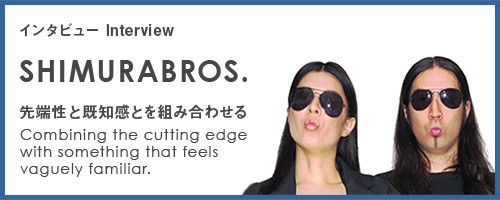
Sister and brother art team Shimura Yuka and Kentaro, better known as the ShimuraBros, exemplify a new breed of Japanese contemporary artists who are firmly based in Japan but keen to show internationally. Dressed in black, the duo are playful, focused and modest. Their work is eclectic – incorporating elements of sculpture, installation and avant-garde filmmaking. Through a process of slowing down and splitting up, it reveals the mechanisms of the production of the image, combining the futuristic with the nostalgic.
Interview: Rachel Carvosso
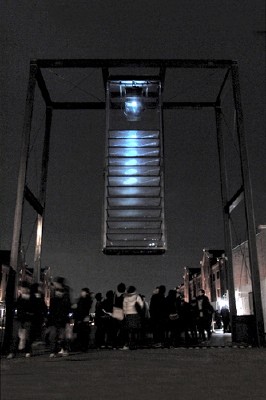 Hibernation 2009
Hibernation 2009Special liquid crystal film, acrylic, iron, stainless steel, PC,
control board, projector, speaker 900 x 700 x 300 cm
Installation at Yokohama Red Brick Warehouse Art Rink 2009
– How did you get involved with the International Festival for Arts and Media Yokohama?
Kentaro We were invited by the director, Sumitomo Fumihiko, after he saw Hibernation (a 9m tower sound and video installation at the Red Brick Warehouse in Yokohama). As children we visited Nogeyama Zoo and when we went to see it again we thought the space was interesting.
– You often use film to unify imaginary and physical spaces, as you have in MMY (Mouse Made in Yokohama). Is there any specific connection between your choice of the icon Mickey Mouse and the site for this particular installation?
Kentaro The zoo has a small area where you could once handle all sorts of animals, but now only small animals, like mice. The connection becomes the physical handling of the animals and the animation character Mickey Mouse, who is famous but ephemeral. We digitally removed the image of Mickey frame by frame from the animation you view on a TV screen in one part of the space and created a form that’s projected onto multiple screens in a second room. What you see is an outline that appears Mickey-like, but is actually an amalgamation of a mouse, camera parts and a silkworm.
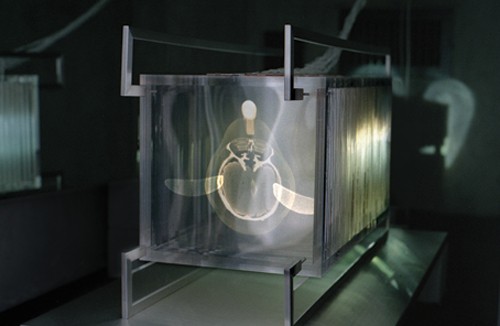 MMY: Mouse Made in YOKOHAMA 2009
MMY: Mouse Made in YOKOHAMA 2009Special liquid crystal film, acrylic, stainless steel, mirror, PC, control board, projector, speakers
34 x 66.8 x 94.5 cm
Installation at Nogeyama Zoo for the CREAM: International Festival for Arts and Media Yokohama 2009
Yuka It was important for us to make reference to Yokohama. This being the Festival’s first edition, we thought it would be interesting to use materials related to the city. Yokohama was home to Japan’s first commercial photo studio and a flourishing silk trade.. In MMY we combine two silkworms and the outline of a mouse’s body with the parts of a camera thus connecting the three.
Kentaro We made a connection between the mechanisms of a living creature and of the workings of a camera. The ‘animal’ is an important part of the zoo and of Japanese culture and animation. The absence of Mickey highlights the presence of a different kind of body – one that was photographed and used as a record of time. In looking at the space where the body was, we also look at a kind of image of the past.
– Your work uses both sculptural elements and more traditionally cinematic, screened elements; formally the structures are quite different. How do these two compliment each other or work antagonistically in the sense of any narrative becoming nonlinear?
Kentaro In Bio Furniture (projected onto three screens) there is no clear beginning or end, but depending on what people see or hear, they piece together their own interpretation of the story. It might look like three different films but gradually people put together something, they connect the narratives.
Yuka All of our work is based on film. For the Viridi-anne project EICON (large screens depicting walking and suspended figures in slow motion) we equated the movement of the model’s body to the action in slapstick comedy. We wanted to create something that showed the physicality of the action and highlighted the formal aspects of film. It was filmed in such a way that the slowed-down motion emphasized the small movements of the model’s body so that the capturing of the motion becomes part of the structure of the piece. It has similarities to the work of Buster Keaton or Charlie Chaplin.
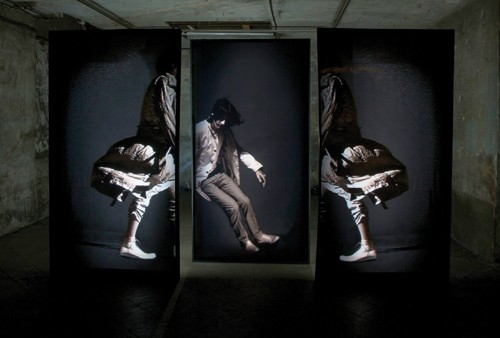 EICON 2008
EICON 2008Synchronized triple-projection on special black surface screens
30 min, color, high-speed 220 x 108 x 10 cm
‘Breathe’ a part of The Viridi-anne’s Paris Collection / Gallery éof Paris
– Do you think there’s a big difference between the audience reception of your work in Japan and abroad?
Yuka In 2003, our film Ought to do and Ought not to do was shown at the Berlin film festival in the Talent Campus segment. That experience was very important for us. We met many interesting directors, the likes of Wim Wenders, there and this made us want to show our work more in other countries.
Japanese audiences are very respectful – quiet and static. They sit and watch, but don’t go around the pieces. When we showed EICON in Paris, the audience went behind the screen and touched it to feel its physicality. In Vienna we showed X-Ray Train at MQ Museum Quatier and there people went between the screens. I asked one man why, and he said it was very exciting because he felt as if the train was coming towards him. Some children were trying to catch the screen, so we thought they must have also felt the existence of the image.
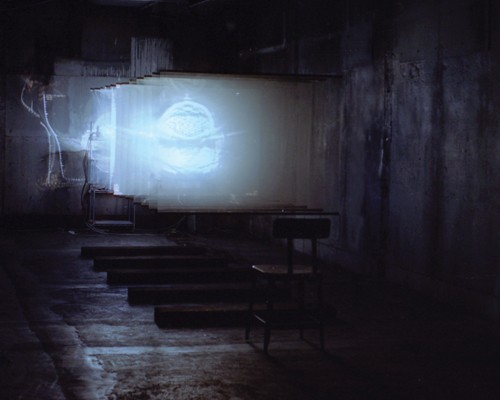 X-RAY TRAIN-LUMIÉRE BROS to SHIMURA BROS. 2008
X-RAY TRAIN-LUMIÉRE BROS to SHIMURA BROS. 2008Special liquid crystal film, iron, wire, PC, control board, projector, speakers, railroad ties 120 x 90 x 600 cm
Design Tide 2007, Tokyo / Electrical Fantasista 2008, Yokohama
Kentaro For the man there was perhaps some implication of danger – the sensation of being close to a train even though it is just an image. We also found in Austria that there was a lot of debate about the pieces; the questions were different, questions like, Is bio furniture possible or impossible?
– Who are your creative influences? Do they come more from art or film?
Kentaro Our father likes Hollywood films so when we were little we watched a lot of Schwarzenegger movies. When we were in junior high school, I saw an NHK program about Luis Bunuel’s films. I didn’t understand his work, but started watching more and was really inspired. It was then that I decided I wanted to make films. During summer vacation I would go to the science museum to look at the light bulbs. I was really fascinated by how things worked and their histories. I think when I was older this really influenced the kind of work I became interested in making.
Yuka For me, the art history books we read in elementary school introduced me to art. We grew up here in Yokohama. Our grandfather Shimura Yoshizo was an inventor and painter, who loved Mt. Fuji. The first time he painted Fuji-san, he rendered it as a winter scene covered in snow, but the next day, when we came back after school, the image had been changed to a spring scene. This influenced our thinking about painting: it is usually static, but his was moving. It was easy for us to make the transition to working with film because we were able to relate it to this idea of something static moving. A lot of media art has a kind of digital effect, but we are very careful to always work with the materials and the colors like in painting.
– What are your future plans?
Yuka If we have the chance we’d like to show X-Ray Train in Lyon, because that’s where the Lumière brothers were born. Yokohama and Lyon are twinned – they’re sister cities!
It’s difficult to fit our work into one category. It is sculptural, conceptual and media related. As far as the creation of new work we have many ideas. By expressing information three-dimensionally, we want to make images that have a kind of body. What we want to try to show is pieces that seem almost real when we create a 3D experience. Unlike, for example, when you watch films, where you are very aware of its unreality.
Kentaro We want to re-work film so that it will exist in real space. Film has duration and we want to keep playing with its form.
ShimuraBros
Shimura Yuka, born in 1976, earned her BFA from Tama University (Tokyo) and MA at Central St Martins (London). Shimura Kentaro, born in 1979, studied at Tokyo Polytechnic University, College of Art, Department of Cinema. Collaborating together since 1999, they have exhibited and screened works in numerous venues throughout Europe and Japan. In 2008 X-Ray Train Lumiere Bros to Shimurabros was shown in the BANK ART Under 35 selection of the Yokohama Triennale, and they created EICON for designer Okaniwa Tomoaki of the Viridi-anne to showcase his spring/summer09 collection. Earlier this year they exhibited X-Ray Train in Vienna at MQ Museum Quatier, and an updated version of the piece at ZAIM in Yokohama. Their newest installationMMY (Mouse Made in Yokohama) is showing at Nogeyama Zoo through 29 November as part of the International Festival for Arts and Media Yokohama.
